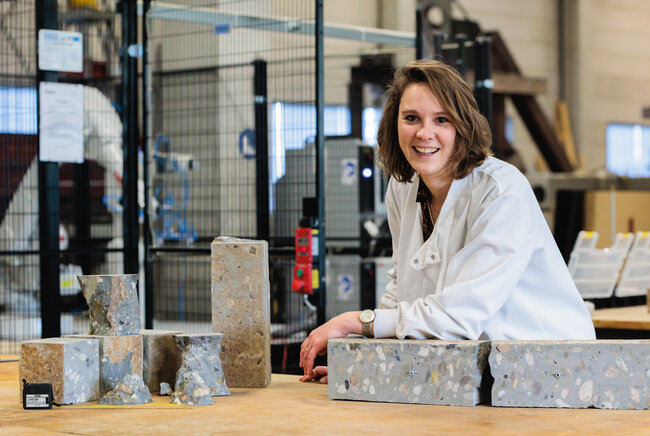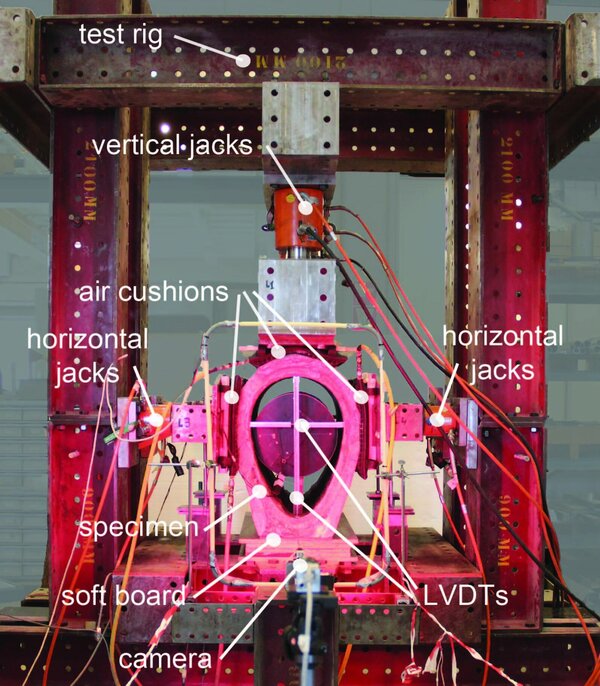Checking on the strength of ageing sewer pipes
Irene Scheperboer defended her thesis at the Department of Built Environment on February 14th 2023.

The majority of our sewer pipes were constructed just after World War II. As their average lifespan is around eighty years, the end is in sight for these pipes. Capacity is insufficient to replace the entire sewer network, but this may not be necessary anyway, says TU/e engineer Irene Scheperboer. She researched the strength of sewer pipes that have been in the ground for a long time and developed an advanced model that outdoes existing methods of determining whether a pipe needs replacing.
“I work in sewage.” When people at a party ask her what she does, TU/e researcher Irene Scheperboer answers the question in this deadpan way. A little laughter on the inside, as Scheperboer – “preferably in a dress and heels” – likes to shake things up a bit. But she did really spend the past five years intensively studying our sewer system. On Tuesday February 14th, she defended her PhD thesis at the Department of the Built Environment.
Sewer robot
As her research progressed, Scheperboer became more and more fascinated with the hidden world underground, as she likes to call the sewer system. After World War II, in the midst of rebuilding efforts, a large-scale system of pipes and drains was put in place under Dutch cities and villages. These sewers dispose of rain and waste water in a safe and – above all – hygienic way. Most of the pipes are concrete.
Scheperboer shows us a few pieces she used in her experiments. The smallest pipe measures 400 mm, while the biggest one is a whopping 800 mm wide and 1,200 mm high. And what’s surprising, is that the latter isn’t round but oval. You see this a lot in gravity sewer pipes, the PhD student explains. “This system uses gravity to make the waste water flow to its destination. The pipes were put into the ground at a slight angle. The top half of the pipe is round, tapering off towards the bottom. This means that even if it’s not raining that heavily, the sewage can quickly and easily pass through the smaller gutter. And when there is a real downpour, there’s sufficient capacity to process the extra intake thanks to ample space at the top.”
With an average lifespan of around eighty years, many sewer pipes are nearing their end. Scheperboer says that if we don’t want to be knee-deep in sewage at some point, we urgently need to start doing a better job of assessing the quality of our sewers.
“The current inspecting method consists of a robot with a CCTV camera moving through the pipes via the drains. Sure, it can see a lot, and even do a three-sixty and zoom in, but it’s still just footage," says Scheperboer. "The municipalities of The Hague and Arnhem gave us some old sewer pipes so we could perform measurements on them. This allowed us to test the remaining strength of the pipes, study the structural characteristics of the concrete and investigate to what extent the pipes were compromised.”

Sulfuric compounds
The sewage flowing through the pipes isn’t exactly clean and contains all kinds of chemical substances, Scheperboer explains. “Sewer pipes are often damaged by biogenic sulfuric acid corrosion. Sulfuric compounds in the sewage are converted to hydrogen sulfide – enter the famous rotten egg smell – by bacteria. Other bacteria then convert it into sulfuric acid, which can react with the concrete. The gypsum formed in this process is a much more brittle material, which easily separates from the wall. So the pipe is sort of eaten from the inside and is therefore getting thinner and thinner.”
The Sewer Babes
In the lab, Scheperboer worked closely with a postdoc under the name 'The Sewer Babes'. Together, they created an impressive setup allowing them to measure wall thickness, tensile strength, and concrete stiffness for each pipe.
Scheperboer notes that they first tested the pipes in their entirety, before cutting off smaller material samples. “This way we could determine to what extent the corrosion had actually affected a pipe’s wall. As it turns out, the CCTV camera doesn’t always paint an accurate picture of reality. Sometimes a pipe would look quite compromised already, but was found to have a thick layer of healthy concrete underneath. Conversely, we often saw pipes that looked relatively good but had already lost half of their wall thickness. So to determine whether you need to replace a sewer pipe right away or if it’s still good to go for another ten or even twenty years, measuring the thickness of the wall is very important. Ultimately you’d want a reliable tool allowing sewer managers to gauge the pipe quality themselves. We took the first steps in that direction.”
Based on the experimental data, Scheperboer subsequently developed a model that can simulate the collapse behavior of sewer pipes. “We observed that the effective wall thickness of a pipe is the most important predictor of how long it’ll be good still. We’ve also found that a pipe always collapses as a result of four tears springing up more or less simultaneously. Only one of these tears can generally be seen on camera images, with the other ones being either on the outside or hidden from sight by the dirty sewage. You then have four stiff parts connected by hinges, as it were. This responds very differently to pressure and is much more unstable than a pipe with one crack. This means the system can suddenly collapse, for example when there are digging activities close to such a pipe.”
Sinkhole
Another possible reason for a sewer pipe to collapse is the washing away of soil around it, changing the distribution of tension. These kinds of situations are very hard to measure in practice – after all: when you excavate the pipe the pockets around it disappear – and are not captured by the camera either. But Scheperboer did manage to gain an insight into the process of ground erosion, using a finite element model (FEM).
This involved dividing the model sewer pipe up into small chunks or elements. When she then put pressure on the pipe – in the erosion model this may also be caused by flowing groundwater – the tensions and warps were calculated locally, i.e. per element. Add everything together and you have an idea of how the erosion pocket develops. Scheperboer’s research showed that one type of soil erosion hardly causes any subsidence, but another type, where groundwater and soil flow into the pipe through a hole in the wall, can lead to big empty pockets in the ground. “Without us noticing, more and more soil is washing away, making the system unstable. This may lead to a huge subsidence, also known as a sinkhole, which can lead to dangerous situations. So, if we now see a massive leak somewhere we’ll know to act right away instead of letting it be for a few years.”
The complex world of sewers still has her in its grips, Scheperboer concludes with a smile. She took a job as an Underground Infrastructures project manager with research institute IKT a year and a half ago, allowing her to keep working on all kinds of subsurface problems. So yes, she still very much works “in sewage”.
Source: Cursor.
Media contact
Latest news


